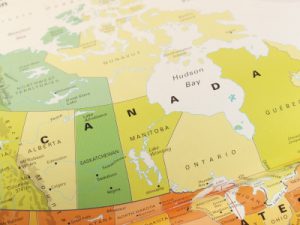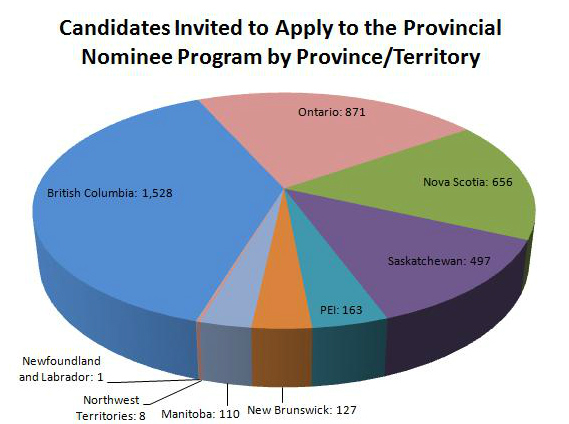New Report Reveals Popular Destination Provinces for new Immigrants to Canada
 Have you ever wondered which provinces have selected the most candidates since Express Entry was launched?
Have you ever wondered which provinces have selected the most candidates since Express Entry was launched?
The provinces of Alberta, Ontario and British Columbia were the most popular destination provinces among applicants for immigration to Canada through Express Entry, while Nova Scotia and Saskatchewan have been very active in attracting newcomers through the immigration selection system, which was launched last year.
A new report published by Immigration, Refugees and Citizenship Canada (IRCC, formerly known as CIC) provides a range of insights into the provinces that are attracting the most new immigrants through Express Entry, as well as which provinces have issued the most enhanced provincial nomination certificates throughout 2015. Data provided in the report covers the period from January 1, 2015 to January 3, 2016.
Over the course of 2015, IRCC received 21,562 applications for permanent residence from candidates who were invited to apply during the invitation rounds, with an additional 15,862 family members joining principal applicants on applications (making a total of 37,424 applicants and their family members). By January 3, 2016, a total of 14,058 applications had been approved, resulting in 13,241 visas issued to principal applicants and their dependants, and 9,739 admissions (“landings”) in Canada.
While Alberta edged out Ontario as the most popular destination province, attracting 7,996 (37.1%) of all applications submitted, it should be noted that the vast majority (58%) of applicants choosing Alberta were invited to apply under the Canadian Experience Class (CEC). In the report, IRCC stated that earlier draws selected a large number of CEC candidates because of the high number of foreign workers with Labour Market Impact Assessment-backed job offers who wished to settle in Canada permanently. It is very likely that a significant number of these applicants were Alberta-based foreign workers who moved to Alberta between one and five years ago.
As we moved deeper into 2015, when Ontario and British Columbia unveiled a range of enhanced Provincial Nominee Program (PNP) options, it is quite likely that the relative number of applicants choosing to settle in either of these provinces increased. In any event, Ontario and British Columbia will no doubt continue to attract significant numbers of newcomers, as they both have growing economies and diverse towns and cities where immigrants can feel at home.
Applications received by province of destination
Province of Destination |
FSW |
CEC |
FST |
PNP |
All Programs |
Alberta |
1,974 |
4,637 |
1,385 |
- |
7,996 |
British Columbia |
1,672 |
1,295 |
199 |
1,218 |
4,384 |
Manitoba |
77 |
48 |
9 |
103 |
237 |
New Brunswick |
29 |
19 |
2 |
89 |
139 |
Newfoundland |
29 |
17 |
14 |
- |
60 |
Northwest Territories |
11 |
15 |
1 |
5 |
32 |
Nova Scotia |
103 |
48 |
5 |
497 |
653 |
Nunavut |
3 |
5 |
- |
- |
8 |
Ontario |
4,670 |
1,833 |
199 |
646 |
7,348 |
PEI |
7 |
5 |
- |
122 |
134 |
Quebec |
- |
- |
3 |
- |
3 |
Saskatchewan |
111 |
117 |
30 |
299 |
557 |
Yukon |
7 |
4 |
- |
- |
11 |
Total |
8,693 |
8,046 |
1,844 |
2,979 |
21,562 |
Readers should note that the province of Quebec has a unique immigration system with its own eligibility criteria. The main economic immigration program in Quebec is the Quebec Skilled Worker Program, and Quebec intends to welcome many thousands of newcomers through this program in the near future. To learn more, click here.
Which provinces are selecting new immigrants through Express Entry?
As the table above and pie chart below show, certain Canadian provinces have been more active than others with respect to attracting newcomers through their enhanced PNP streams, which are aligned with the Express Entry system. Provinces can use these PNP streams to select immigrants who may benefit the local labour market. All Canadian provinces and territories, except for the provinces of Quebec and Alberta and the territory of Nunavut, have opened Express Entry-aligned PNP streams.
Candidates in the Express Entry pool who successfully obtain an enhanced provincial nomination certificate are awarded 600 Comprehensive Ranking System (CRS) points, and will be invited to apply for Canadian permanent residence at a subsequent draw from the pool.

Some enhanced PNP streams, for example those offered by the governments of Nova Scotia, Ontario, and Saskatchewan, do not require candidates to have a prior connection to the province in order to make an application. Interestingly, these programs were among the most popular over the course of 2015.
Here is a full list of PNPs that offer at least one Express Entry-aligned immigration stream:
- British Columbia Provincial Nominee Program (BCPNP)
- Manitoba Provincial Nominee Program (MPNP)
- New Brunswick Provincial Nominee Program (NBPNP)
- Newfoundland and Labrador Provincial Nominee Program (NLPNP)
- Nova Scotia Nominee Program (NSNP)
- Ontario Immigrant Nominee Program (OINP)
- Prince Edward Island Provincial Nominee Program (PEI PNP)
- Saskatchewan Immigrant Nominee Program (SINP)
- Northwest Territories Nominee Program (NTNP)
PNPs in 2016
According to its Immigration Levels Plan for 2016, which was published last month, the government of Canada has set an admission target of 47,800 for the PNPs, which are expected to continue to have an increasingly role within Express Entry throughout 2016 and beyond.
Knowledge is power, but being proactive is too
“The more candidates learn about Canada — its regions, its provinces, its economy, and the employment opportunities throughout the country — the more likely it will be that they will be well positioned to immigrate to the country. A big part of that is staying up-to-date on which occupations are in demand and where these jobs may be,” says Attorney David Cohen.
“Though provinces may have initially been more like interest observers over the opening months of Express Entry, later in 2015 and into this year they have been increasingly active in their pursuit of new immigrants, who are desperately needed in some parts of the country. This report from IRCC confirms a simple reality. Applying to one or more of the Provincial Nominee Programs increases a candidate’s chances of successfully immigrating to Canada.”
Eligible candidates may submit a profile into the Express Entry pool, where they are ranked according to the CRS. The government of Canada selects the top-ranked candidates on a priority basis when it performs one of its frequent draws from the pool.
Candidates who are issued an ITA for permanent residence then have 60 days to submit a complete e-application, from which point the government of Canada aims to process the application within six months. For more information on draws from the Express Entry pool that have taken place so far, click here.
CICNews.com has published two further accompanying articles relating to this report:
- Long-Awaited Express Entry Report Gives Important Details on Occupations and Candidates Selected for Immigration to Canada
- Inside the Comprehensive Ranking System: Express Entry Report Offers Valuable Insights from the Pool
To find out if you are eligible for any of over 60 Canadian immigration programs, including the federal economic programs that are processed under Express Entry and the various Provincial Nominee Programs, please fill out a free online assessment today.
© 2016 CICNews All Rights Reserved
- Do you need Canadian immigration assistance? Contact the Contact Cohen Immigration Law firm by completing our form
- Send us your feedback or your non-legal assistance questions by emailing us at media@canadavisa.com




